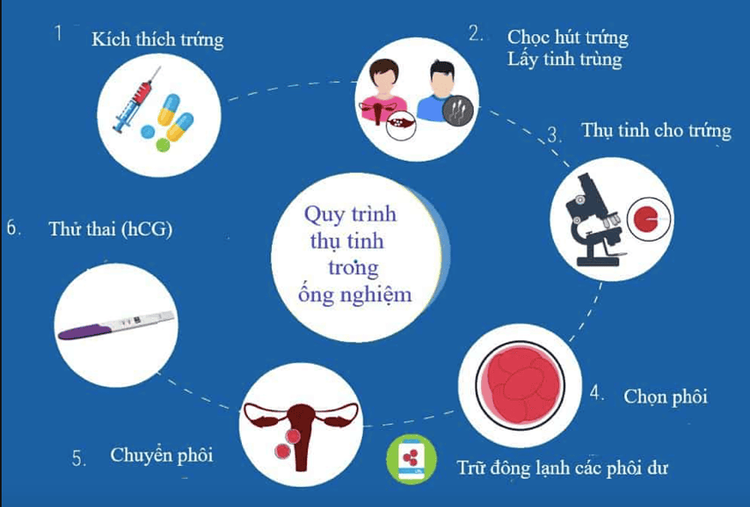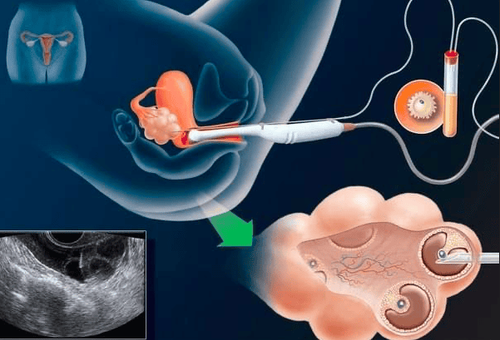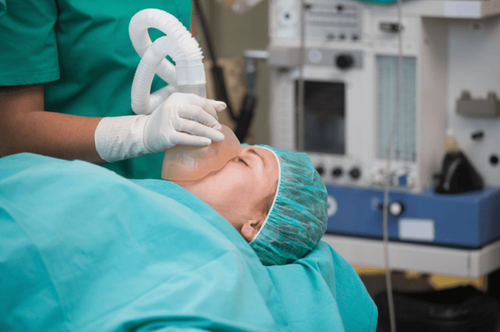This is an automatically translated article.
Posted by Specialist I Tran Thi Anh Hien - Anesthesiologist - Anesthesiology Department - Vinmec Central Park International General Hospital
In Vitro Fertilization (IVF) is a complex medical technique used to treat infertility, infertility or genetic problems related to sex. Currently, this is the most effective medical method of assisted reproductive technology. So during IVF, how is the patient anesthetized?
1. Stages of in vitro fertilization
What is in vitro fertilization? In Vitro Fertilization (IVF) is a complex medical technique used to treat infertility, infertility or genetic problems related to sex. Accordingly, the process of performing IVF is divided into the following stages:This process includes the following stages:
Egg stimulation and monitoring Transvaginal ultrasound aspiration, sperm collection and treatment Egg fertilization Embryo selection Intrauterine embryo transfer Beta HCG

In 1978 the first in vitro fertilization (IVF) was performed with endoscopic egg retrieval. Currently, egg aspiration is the preferred choice to perform under the guidance of transvaginal ultrasound. This technique can be stressful and painful. Therefore, when performing egg aspiration, it is necessary to apply an anesthetic measure to ensure the convenience of the procedure and the safety of the patient. Anesthesia plays an important role in helping the egg retrieval technique to be carried out effectively.

2. Anesthesia methods in IVF
There are many methods of anesthesia in IVF such as: general anesthesia, sedation with or without local anesthesia, paracervical anesthesia and pre-ovarian anesthesia. The ideal anesthetic method is safe and comfortable for the patient to experience the procedure, without affecting the quantity and quality of eggs - fertility - embryo development - pregnancy rates, medications short-acting with few side effects.
Currently, most fertility centers in Vietnam apply sedation with or without combined with paracervical anesthesia to anesthetize patients when performing related techniques. to assisted reproduction.
3. Some drugs commonly used in anesthesia for in vitro fertilization
There are two main factors to consider when choosing a drug: the ability to penetrate the follicular fluid and the toxicity of the drug.
3.1. Propofol Propofol is an intravenous anesthetic that has been on the market since 1986. Propofol has obvious advantages such as: rapid action, short duration of action, no relation to previously used drugs, and anti-inflammatory properties. vomit. The amount of propofol in the follicular fluid increased with time, but had no deleterious effects on oocyte, fertilization, early embryonic development or pregnancy and abortion rates. Because of these advantages, Propofol is the preferred anesthetic ingredient in assisted reproductive techniques, which can be combined with Fentanyl
3.2. Midazolam Midazolam has cognitive sedation, with the advantage of not having any effect on egg and embryo development. The drug is recommended for sedation for patients undergoing IVF procedures. The combination of Midazolam and Fentanyl is thought to be a good combination for ultrasound aspiration.
3.3. Fentanyl Fentanyl is a strong pain reliever, acting quickly within 30 seconds after intravenous injection, lasting for 20-30 minutes, does not affect egg fertilization and embryo implantation in the above study. people and animals.
Alfentanil and fentanyl were detected at extremely low concentrations, almost non-existent in the follicular fluid after oocyte retrieval. Alfentanil has a 10:1 ratio of plasma to follicular fluid 15 minutes after the first bolus dose.

4. Steps to perform anesthesia for IVF
Before performing anesthesia for IVF, the anesthesiologist will perform the same pre-anesthetic examination steps as in the case of other procedures or surgeries. The anesthesiologist will explain and advise the patient on the necessary steps to facilitate the procedure and minimize complications. Patients need to fast for at least 6 hours before the procedure, with clear liquids such as: water - sugar water at least 2 hours before the procedure.
The steps to administer IVF anesthesia are as follows:
Prepare the patient Instruct the patient to lie on the table in the obstetric position Establish an intravenous line Give oxygen 3 l/min Pre-anesthesia with Fentanyl Sed with Propofol TCI control target concentration Clean vulva, vagina with NaCl 0.9% Egg aspiration under the guidance of transvaginal ultrasound Monitor monitor: ECG, blood pressure, SpO2, breathing rate Administer medication analgesia after Perfalgan procedure 1g IV over 15 minutes if needed In assisted reproductive technology, the most frequently performed technique and always requiring anesthesia is egg retrieval, followed by abortion. In addition, ovarian cyst aspiration (kyst) in some cases also requires an anesthetic process.
The process of anesthesia for IVF can also experience unwanted complications such as nausea, vomiting, aspiration of gastric juice, cardiovascular collapse, respiratory failure, anaphylaxis. Therefore, during the procedure, the anesthesiologist needs to closely monitor the patient's condition for early detection and timely treatment to ensure patient safety.
To ensure safety and limit complications, when performing in vitro fertilization, customers when performing artificial insemination need to choose a reputable medical facility with the equal coordination of their doctors. both anesthesiologists and obstetricians.
Anesthesiology and Anesthesia Department and IVF Reproductive Center of Vinmec International General Hospital are highly appreciated by patients for their professional quality and care, helping the patient's treatment and recovery process. achieve the best performance. At Vinmec, there are:
Apply the world's most advanced techniques: The world's most advanced epidural analgesia (ESP) technique; Anesthesia by ultrasound machine, do not use morphine to relieve pain. The team of leading experts: The doctors are well-trained and experienced, and are members of the Anesthesiology Associations in Vietnam and Europe. Cooperate with leading professors and experts at domestic and international frontline hospitals to exchange techniques and apply the latest methods of anesthesia and pain relief. Professional - comprehensive patient care: patients are fully and fully consulted before anesthesia and analgesia before and after; apply an early recovery program after surgery for patients; guide appropriate methods of exercise and rehabilitation so that patients can return to normal activities soon. Especially with the IVF procedure, the team of anesthesiologists and anesthesiologists will coordinate equally with the obstetrician-gynecologist to ensure maximum safety and bring the highest success rate.
Please dial HOTLINE for more information or register for an appointment HERE. Download MyVinmec app to make appointments faster and to manage your bookings easily.














